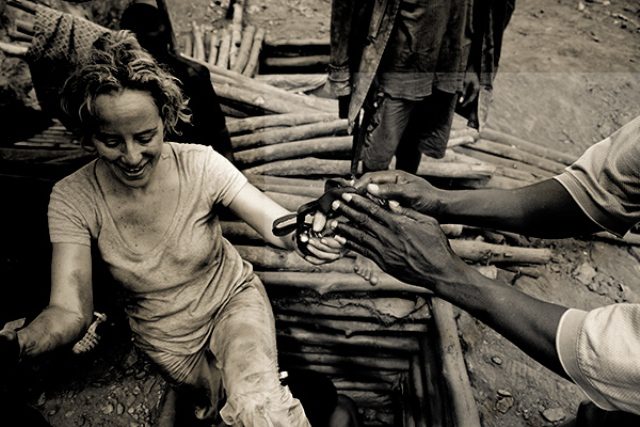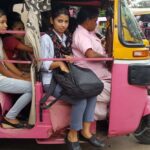
Humanitarian and fine art photographer Lisa Kristine chats with Girls That Roam about photographing cultures around the world, modern day slavery and seeing it all through the lens of her camera
The first time I saw humanitarian photographer Lisa Kristine’s photographs was with my roommate, Mel, in Sausalito, California.
That fall morning we rode our bikes through the Presidio and over the Golden Gate Bridge down into the quaint bayside town Sausalito with our partners for a picnic. Mel had a piece of paper with her about Lisa Kristine’s gallery and was telling me about it as we locked up our bikes.
We strolled about a block when the corners of Lisa’s photographs displayed in a window began to be revealed as we took each step closer. They were brilliant, vibrant with colors and life of indigenous people in distant lands. Stepping into the gallery we were whisked away beyond the borders of the San Francisco Bay Area and the United States into alternate realities and ways of being and existing.
The landscapes were breathtaking. The people were far removed from our teched up modern world stripped down to the bare essentials, but in no way plain or ordinary. They were the people of my and Lisa’s imaginations as children reading anthropology and geography books and closing our eyes, spinning the globe and stopping it on a random country to read about.
The Sausalito gallery has since closed, but her photographs are etched into my memory to the point that I insist on stopping by the Lisa Kristine Gallery on the plaza in Sonoma to take a stroll through the portraits hanging on the walls and sift through the various size images available for purchase during each visit.
It’s an experience that is never the same as Lisa has thousands of images in her archives that span more than three decades that she hasn’t printed yet. From time to time she pulls out new images that were taken years ago to display constantly refreshing her gallery.
Girls That Roam recently had the opportunity to sit down with Lisa to talk about her career as a humanitarian photographer, modern day slavery and traveling in uncharted regions of the world.
Lisa, who is a 48-year old mother of two adopted kids, one from Ethiopia and one from Guatemala, has traveled to more than 100 countries and six continents since she began professionally photographing people when she was 18 years old.
“I’m away so frequently, it’s just really fluid to leave and come back home and jump into the studio,” and have “some wonderful time spent with my family jump on off on a project and then return again.”
When she returns home from a journey the first thing she does is “squeeze my children,” she says laughing.


Seeing the World through the Lens
Photography has been Lisa’s life, literally. She has been shooting photos since she was handed her first Olympus camera as a gift from her aunt and uncle, whom she lived with when she was 11 years old in Orinda, California. She would work with her uncle in his darkroom meticulously observing her photographs and the process of developing what she photographed in the world in the darkroom.
“I would work with him and those prints were really bad when I would get them made,” she says laughing.
That didn’t stop her though. She continued to work, meeting her mentor, Ted Laufer, two or three times a week he taught her the craft of photography and printing, showing her Ciba Chrome printing.
“That really honed my skill,” says Lisa, who always took detailed notes, including sketches of what she was photographing daily and immediately developing the shots within 24-hours.
“That’s really how I taught myself,” says Lisa, about learning her craft and style with the assistance of mentors throughout her teens.
“When people ask me, “‘What do you recommend I do? Should I go take a class?’ That would be good, but really you just have to do is just do it. Start looking at your results and learn from them.”
“Photography was something that I had always just had an inclination for,” she says.
People have always been her subject of choice. She photographed her family and other people, but she was also attracted to anthropology.
“I was the one always marveling at anthropology books and you know I saw these people of ancient tradition and lived near the earth,” says Lisa. “I was moved by them. I saw them as being very strong and solid. I remember actually making a decision when I was a little girl that when I was old enough I would go meet these people. I just had a desire to meet them.”
“I just thought that they had something that I could glean some wisdom from,” she continues.
During her formative years as a budding professional photographer on the road, Lisa lived in many remote and indigenous cultures.
“That’s kind of how it was born. It wasn’t a purposeful thing in me setting out to do that. It’s just that [her interest and photography] all happened to collide together,” Lisa says.
“I just loved the arts. It was just a passionate hobby, but as I delved more deeply into it, it just ended up falling into my lap as a career. It wasn’t expected. It was sort of a marveling feeling to say, ‘Wow, people will pay me to do this? It just opened up a whole new universe to me.”


When she returned to the US, Lisa began showing her photographs during her global journeys at small shows. A guy who owned a Photo Vault, a stock photo agency, discovered Lisa during one of her shows and recruited her to work for the agency. That quickly led to her establishing herself professionally and going out onto her own exhibiting her work at different shows.
“I was fortunate that people acquired the pieces and it just sort of organically grew,” says Lisa.
The magic of her work is looking for the light and specific moments that tell the story of the people.
“The vibrancy and the color really comes from working in the field with the camera through really observing light and working when it becomes sort of what I’m looking for,” says Lisa. The rest of the work in the darkroom and her photo studio is simply technical.
“The printing process is really about making an image from what was made in the field, if you will, just replicating that,” says Lisa, whose work is still vastly film, not digital, working on her 19th century view camera and 4 x 5 sheets of transparency film that she crafts most of her work on.
How did she hone her skill? Taking photos daily and meticulously documenting what she did daily.
“That really honed my skill,” says Lisa, who always took detailed notes, including sketches of what she was photographing daily and immediately developing the shots within 24-hours.
“That’s really how I taught myself,” says Lisa, about learning her craft and style with the assistance of mentors throughout her teens.
“When people ask me, “‘What do you recommend I do? Should I go take a class?’ That would be good, but really you just have to do is just do it. Start looking at your results and learn from them.
Lisa also suggests when traveling, “Make a plan if you need to, but leave room for the magic.”
Be respectful of people and other cultures when taking pictures, particularly of people.
“Ask for permission,” says Lisa. “That to me is the very most important thing.”


Lessons of the World
Her travels have taught her that there are “many ways to be alive,” she says.
“There’s a thousand ways to be alive and that is largely why I travel,” Lisa says. “We have this ability to create our lives.”
It is the freedom of roaming and meeting people that continues to call her to leave her two children and gallery at home in Sonoma back out onto the wide open road in an endless, seamless flowing pattern.
“Traveling renders ones openness and sense of possibility in life. That is the true university,” says Lisa.
At the tender age of 18 years old, Lisa packed her backpack and camera and set off from Orinda, California, where she grew up, to meet the indigenous people from her childhood anthropology books. She didn’t return for five years.
“I always say it’s a place where nothing happens,” says San Francisco-born Lisa, about Orinda. The world was her classroom and she met all of the right people who helped guide her in her journey.
“It is the greatest teacher because you meet people who may appear different and may do some things different, but there is this common human connection: what I call this human thread that really binds us.”
“One of the most essential and important ideals about being alive is being able to travel,” says Lisa.
It doesn’t matter where she’s going or how many times she’s visited a place. She’s drawn to exploring every inch of this earth and observing the places she’s familiar with, she says. Especially Asia, Asia is the continent that resonates the most with her and where she finds herself laying her head a lot.
To keep her focused, she made a big change within the past five years. She consolidated her four US galleries and reduced the size of her team to the one in Sonoma, where she’s lived and worked for nine years, and schedule more museum exhibitions. It was a plan to allow her to get back to her “purposefulness, which is being out in the world making images and really having an impact,” she says.
“It’s just a great community,” says Lisa, who loves being on the plaza. “It’s visited by wonderful people from all over the world.”


Freeing People
Soon after she made the changes in her business structure she happened upon one of her latest passion projects: helping to end modern day slavery.
Lisa has always been philanthropic not only in her work but also in the fruits of her labor, she says. It’s been one of the core values and missions of her gallery.
Yet, in spite of all of her travels and philanthropic ventures, she found herself stunned one night in Vancouver, Canada.
It was 2009, she was invited as the sole exhibitor at the World Peace Summit in Vancouver with His Holiness the Dali Lama and other Nobel Peace Laureates, when she met a supporter from Free the Slaves.
Free the Slaves is an organization fighting to end slavery as it exists in the 21st century.
Suddenly, her eyes were opened to the dramatic effect of slavery.
“I knew slavery existed to some degree,” says Lisa. “I had no idea that slavery had permeated more than 27 hundred million lives on the planet today.”
“I just couldn’t sleep. I felt like a freight train had run me over when my work is utterly about dignity and inspiring unity and the beauty of the world,” she continues. “I couldn’t believe that such an atrocity had existed.”
Living in the Bay Area, Lisa was aware of human trafficking, especially sex trafficking of girls and in the textile industry, such as sweatshops, but these industries are just the tipping point of slavery around the world today. That evening she learned that people are forced into labor all over the world from agriculture and fishing, domestic servitude, mining for diamonds and gold and much, much more.
She grew from being disturbed and upset to being angry first that it existed and second that she didn’t know about it in spite of traveling so consistently around the world.
“Anyway that anyone can be exploited they will do it,” says Lisa. “I thought that if I don’t know how many others don’t know?”
She decided to collaborate with Free the Slaves to help them educate the public to end slavery. This was about five years ago, but it wasn’t until early 2013 that her first book, Slavery, a collection of photographs of people who are currently enslaved around the world was published.
“Once people see what’s happening, really see it, you know you can’t turn your face away from it,” says Lisa, who has climbed down into coal mines with miners forced into free and dangerous labor in Africa as just one of the places she’s been and people she’s photographed.
“The book is really a visual story on modern day slavery and on deliberations of those who have been enslaved,” says Lisa, who is proud that Archbishop Desmond Tutu, one of the vocal advocates to end slavery, wrote the forward. “It’s the gift of hope that we actually can end this thing.
“He so strongly believes in the work and in the work that needs to be done by all of us to eradicate it,” she adds.
The book was accompanied by an exhibition throughout 2014 to raise awareness and money to help fight against slavery. Between 10% and 15% of the proceeds of the book is donated to fighting slavery along with any book and film of her work related to the subject, such as the documentary In Plain Sight, which follows her experience inside Indian brothels.
“It’s really special. I just can’t tell you how it’s a really special thing,” says Lisa.
To book your next uncharted adventure, contact Heather Cassell at Girls That Roam Travel at Travel Advisors of Los Gatos at 408-354-6531at
To contract an original article, purchase reprints or become a media partner, contact







